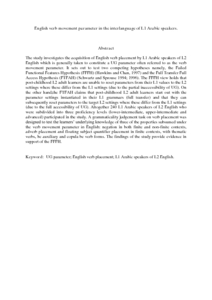Citation
Yahya Ali Muftah, Muneera and Wong, Bee Eng
(2011)
English verb movement parameter in the interlanguage of L1 Arabic speakers.
The Linguistics Journal, 5 (1).
pp. 125-168.
ISSN 1718-2301; ESSN: 1718-2298
Abstract
The study investigates the acquisition of English verb placement by L1 Arabic speakers of L2 English which is generally taken to constitute a UG parameter often referred to as the verb movement parameter. It sets out to test two competing hypotheses namely, the Failed Functional Features
Hypothesis (FFFH) (Hawkins and Chan, 1997) and the Full Transfer Full Access Hypothesis (FTFAH) (Schwartz and Sprouse 1994; 1996). The FFFH view holds that post-childhood L2 adult learners are unable to reset parameters from their L1 values to the L2 settings where these differ from the L1 settings (due to the partial inaccessibility of UG). On the other hand,the FTFAH claims that post-childhood L2 adult learners start out with the
parameter settings instantiated in their L1 grammars (full transfer) and that they can subsequently reset parameters to the target L2 settings where these differ from the L1 settings (due to the full accessibility of UG). Altogether
240 L1 Arabic speakers of L2 English who were subdivided into three proficiency levels (lower-intermediate, upper-intermediate and advanced) participated in the study. A grammaticality judgement task on verb placement was designed to test the learners’ underlying knowledge of three
of the properties subsumed under the verb movement parameter in English: negation in both finite and non-finite contexts, adverb placement and floating subject quantifier placement in finite contexts, with thematic verbs, be auxiliary and copula be verb forms. The findings of the study provide evidence in support of the FFFH.
Download File
![[img]](http://psasir.upm.edu.my/24357/1.hassmallThumbnailVersion/English%20verb%20movement%20parameter%20in%20the%20interlanguage%20of%20L1%20Arabic%20speakers.pdf)  Preview |
|
PDF (Abstract)
English verb movement parameter in the interlanguage of L1 Arabic speakers.pdf
Download (149kB)
| Preview
|
|
Additional Metadata
Actions (login required)
 |
View Item |

